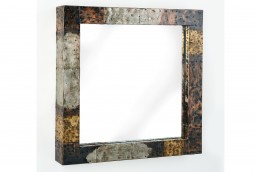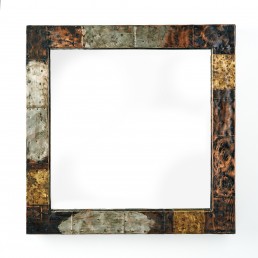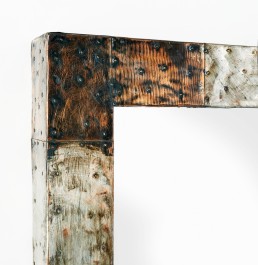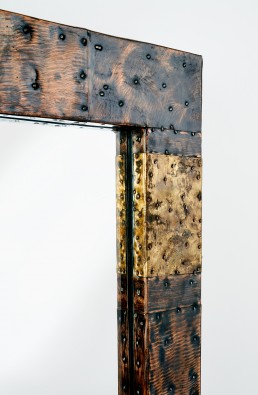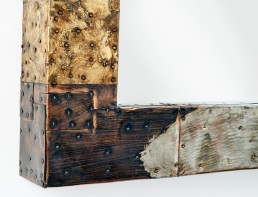Bold Patchwork Mirror by Paul Evans
Paul Evans (1931 – 1987)
A beautifully crafted “Patchwork” mirror in patinated and welded copper, brass, and steel, this piece is an excellent example of Paul Evans’ appropriation of traditional folk art techniques in pursuit of striking modern design.
Excellent condition.
- Origin: U.S.
- Period: 1970's
- Dimensions: 30" H x 30" W x 3" D
- Materials: Copper, brass, pewter, steel, mirror
- Condition: Excellent
Out of stock
Product Description
Wright: PE 18 mirror by Paul Evans for Direction, USA c.1970, patinated copper, steel and brass, mirrored glass (see doc)
Bold, Handsome, Outstanding
Patchwork mirror “An outstanding pair of bronze, copper, and pewter patchwork settees with plush, button-tufted silk velvet upholstery. A rare example of one Evans’ best uses of patchwork bronze. Near perfect original condition with original signature plate signed “AN ORIGINAL PAUL EVANS.” New 100% silk velvet by Rose Cummings in light grey.”
Matching “Patchwork” wall mounted console and mirror in copper, brass and pewter by Paul Evans for Directional Furniture, American 1970s. Console has a slate top.
Mirror:
H: 30 inches
W: 30 inches
D: 3 inches
$5,500
A beautifully crafted coffee or cocktail table by Paul Evans for Directional circa 1970, the base feature four triangular shapes converging at the center to form an architectural spoke. The surface of the steel is patinated and sculpted with studded textures typical of his style.
Medium: Welded and polychromed steel, glass
Dimensions: 16 h x 42 w inches
Condition: Warm patina to original finish on base. Good vintage condition. Unmarked.
A sculpted bronze and glass “Stalagmite” coffee table, the thick round glass top sits on top of a bronze base, decorated with thick impasto like application of bronze over an iron framework. A magnificent example of Paul Evans’ sculptural work – a culmination of his artistic and technical skills.
Excellent Original Condition. Signed PE 1972
A designer and sculptor, Paul Evans was a wild card of late 20th century modernism. A leading light of the American Studio Furniture movement, Evans’s work manifests a singular aesthetic sense, as well as a seemingly contradictory appreciation for both “folk art” forms and for new materials and technologies.
Evans’s primary material was metal, not wood, which was favored by his fellow studio designers, and Bucks County, Pennsylvania, neighbors George Nakashima and Philip Lloyd Powell. He trained in metallurgy and studied at the Cranbrook Academy of Art, the famed crucible of modern design and art in suburban Detroit. For a time early in his career, Evans also worked at Sturbridge Village, a historical “living museum” in Massachusetts, where he gave demonstrations as a costumed silversmith.
Evans’s earliest work unites these influences. The pieces that made his reputation are known as “sculpted-front” cabinets: wood cases faced with box-like high-relief patinated steel mounts laid out in a grid pattern. Each mount contains a metal emblem, or glyph, and the effect is that of a brawny quilt.
Evans’s later work falls into three distinct style groups. His “sculpted-bronze” pieces, begun in the mid-1960s, show Evans at his most expressive. He employed a technique in which resin is hand-shaped, and later sprayed with a metal coating, allowing for artistic nuance in the making of chairs, tables and cabinets. Later in the decade and into the 1970s, Evans produced his “Argente” series: consoles and other furniture forms that feature aluminum and pigment-infused metal surfaces welded into abstract organic forms and patterns.
Last, Evans’s “Cityscape” design series meshed perfectly with the sleek, “high tech” sensibility of the later ’70s. Evans constructed boxy forms and faced them with irregular mosaic patterns that mixed rectangular plaques of chromed steel, bronze, or burlwood veneer. These, like all of Paul Evans’s designs, are both useful and eye-catching. But their appeal has another, more visceral quality: these pieces have clearly been touched by an artist’s hand.

